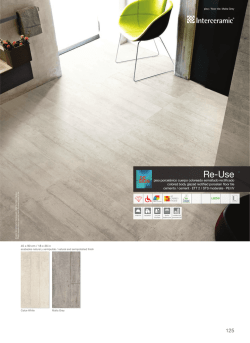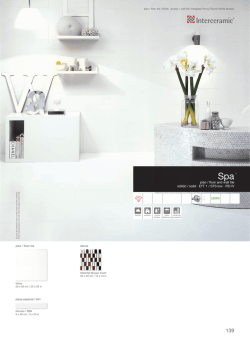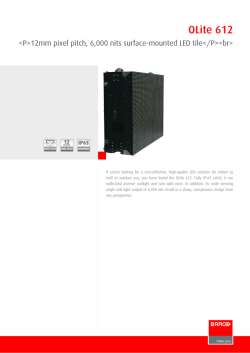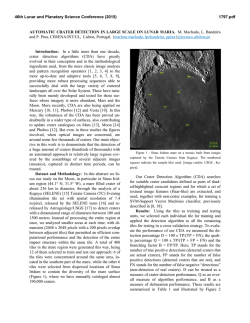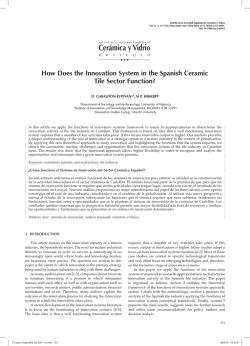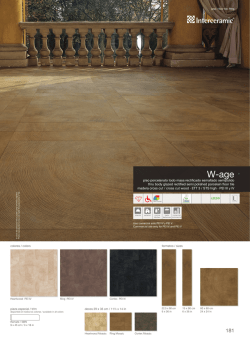
Integration That Works - Camden and Islington NHS Foundation Trust
Page 1 www.onehousinggroup.co.uk INTEGRATION THAT WORKS An evaluation of Tile House Executive Summary Tile House evaluation Page 2 Tile House evaluation October 2014 by Amy Crocker Delivered in partnership with the London Borough of Camden and the Camden and Islington NHS Foundation Trust 1. Forewords and acknowledgements 2.Introduction 05 3. Care Support Plus 05 4. Tile House in context 06 5. Methodology and hypotheses 07 6.Conclusions 09 7. 13 Future actions for consideration References Tile House evaluation 03 14 Tile House evaluation 2 Page 3 1. Forewords and acknowledgements The Care Support Plus model at Tile House is a game changer. The model demonstrates how modern integrated housing can replace a quarter of NHS inpatient beds to the real benefit of customer recovery. Our strategic partnership with the Camden and Islington NHS Foundation Trust, combined with our attractive, specially designed building has allowed the implementation of the Care Support Plus model to raise the bar in supported housing provision for people with complex mental health problems. This report outlines how the model delivers significant efficiencies to the NHS and adult social care while producing notable life changing outcomes for customers. As an expression of the impact of health and housing, Tile House has renewed aspiration within our customers and enabled them to begin building independent and meaningful lives for themselves despite complex mental ill health. The model creates a parity of esteem which has never before been realised. This is a success that we intend to build upon. Our new corporate plan commits the resources to develop a programme to support the progress of the Care Support Plus model into the future. Kevin Beirne, Group Director, One Housing Group The Care Support Plus model shows how the NHS can embrace opportunities to work with high quality housing associations to transform care pathways to the benefit of our patients. Our pioneering partnership with One Housing Group coupled with high quality clinical assurance at Tile House has enabled us to provide genuine alternatives to hospital and out-of-borough placements for patients. The benefits to the Trust and to patients with the most complex needs and highest risks are clear. We are proud to have pioneered an approach that so effectively delivers our values of a positive and dignified recovery journey for our patients. The success of Tile House means we are committed to making the most of further opportunities to work with talented RSLs to deliver the very best outcomes for our patients across London. Wendy Wallace Chief Executive of Camden and Islington NHS Foundation Trust Tile House evaluation Page 4 I am proud of Camden Council’s involvement in, and support of, Tile House, and I’m pleased to have the opportunity to contribute to this report via this foreword. The results from the review are encouraging. The service is contributing to the achievement of one of the Council’s most challenging ambitions, helping to make Camden a place where everyone has a chance to succeed and nobody is left behind. Tile House is tackling long-term inequality and making a real and lasting difference to lives by providing some of the borough’s most excluded residents with access to high-quality local accommodation that is supporting people’s recovery journey. It is a fantastic initiative. Central to the success of the service is the partnership approach from One Housing Group and Camden and Islington NHS Foundation Trust; they are refining how health, housing and support providers work together by breaking down organisational barriers. Working in this way is ensuring tenants are able get the right support, at the right time, in the right place. The results from this are described in the report. It is helping people with severe and enduring mental ill health and particularly complex needs to live as independently as possible, lead more active and healthy lives, have more choice and control over their lives, and continue to develop the skills to manage daily life in the community as they recover from their illness. By learning or regaining these skills we know people will be able to move on from Tile House into more independent settings, including managing their own tenancies. In a challenging economic climate Tile House is improving the experience and outcomes from housing, care and support for those living there. It provides a clear sense of direction for the future. I commend all those involved in this work and would like to thank everyone that contributed to this evaluation. Cllr Patricia Callaghan London Borough of Camden Acknowledgements We are grateful for the ready co-operation and assistance given to us in the collection of data by the manager, staff and customers of Tile House and for the advice and support of One Housing Group and Camden and Islington NHS Foundation Trust management in the drafting of this report. The methodology and review of data in this report has been externally validated by Steve Appleton of Contact Consulting (Oxford) Ltd, who also assisted us with the writing of the report. Amy Crocker Associate Head of Service Development, One Housing Group Tile House evaluation Page 5 2. Introduction During 2012, One Housing Group (OHG) and Camden and Islington NHS Foundation Trust (C&I) entered into a strategic partnership to deliver a unique approach to supported housing and recovery for people with complex mental health needs. This partnership, one of the first of its kind, aims to improve the quality of housing and support for customers through implementation of a jointly developed ‘Care Support Plus’ model delivered in high quality, purpose built accommodation at Tile House. Tile House opened in September 2012 and provides 15 high quality, self-contained supported housing units in the Kings Cross area of London. Each customer has their own flat that is designed to the same specification as our private sale housing. Purpose designed safety features enable us to effectively manage risk, while homely communal areas can be used for workshops and group sessions. Support is delivered in partnership with C&I which provides dedicated, on-site clinical input. An evaluation proposal was jointly developed by OHG and C&I from the outset. This report represents our findings, which covers a two-year period, on the success of the partnership and Care Support Plus model. It also outlines our learning from the model and ideas for future development and wider implementation. 3. Care Support Plus The ‘Care Support Plus’ model brought C&I and OHG together into a formal partnership, delivering a service based on clear lines of responsibility, but with a shared approach to risk and a partnership approach to management and oversight. This model delivers a meaningful, recovery-focused, wraparound service for customers. It enables us to work with people with high levels of risk and complex needs who have previously been excluded from supported housing, including those with forensic backgrounds and those who are subject to Section 37/41 of the Mental Health Act. This integrated health and housing model is specifically designed to support the NHS outcomes frameworks by: reducing reliance on expensive out of borough care and forensic placements reducing hospital admissions, both in terms of frequency of admission and length of stay improving quality of life and outcomes for customers providing a high quality independent living environment. At the same time the model offers considerable value for money through both short term savings in reduced placement fees, and longer term savings through improved and sustained customer outcomes. Tile House evaluation Page 6 4. Tile House in context A greater focus on services that work across health, housing and social care, that can be delivered in the community rather than hospital and which promote recovery and independence have meant new models of support have emerged. In considering the impact of Tile House, it is important to place its development in the context of current policy in health, housing and social care. The mental health strategy for England, No health without mental health1, published in February 2011, stresses the importance of housing for mental health and for those recovering from mental health problems in particular. Good quality, affordable, safe housing underpins our mental and physical wellbeing. In February 2014 the Department of Health launched Closing the Gap. This new ‘action plan’ is intended to provide a bridge between the longer term aims of No health without mental health and the potential for achieving a number of shorter term ambitions. This includes encouraging developers, with some financial resource, to think specifically about homes that can support people who have a mental illness to live safely and more independently for longer.2 Over the past five years increased pressure on NHS and social care budgets has accelerated the focus on creating alternatives to institutional provision. Increasing use of personal budgets has also created opportunities to develop new models of housing support.3 Evidence suggests that there are currently not enough specialised housing options available for people with mental health problems.4 As a consequence housing associations and NHS Trusts need to work together to deliver an integrated pathway that will result in better outcomes for customers. The pressures and associated demands to maximise inpatient capacity in the NHS are often exacerbated by beds being unavailable, including those which are occupied due to delayed discharges. In many cases a lack of appropriate accommodation is a significant factor in a person not being discharged in a timely manner. The development of housing provision that can provide support to people leaving hospital, either on a short, medium or even longer term basis can assist in effecting more timely discharge. The Care Act 2014 gives legislative leverage to improve the quality of care and support. Thus the need to focus on people’s wellbeing and to support them to remain independent for as long as possible is particularly relevant. As a result of the Any Qualified Provider provisions in the Health and Social Care Act5 the market environment in the NHS and social care is expanding to admit a wider range of providers and to promote joint working with other parts of the NHS as well as independent and voluntary sector providers. This greater diversity means that the NHS may no longer be the ‘default’ option for commissioners and enable independent providers to achieve greater penetration in a range of service areas. In addition it provides opportunities for commissioners to consider the role of housing associations in the development of a range of housing, care and support services that might complement or transform existing secondary care provision. Recovery-focused services and the principles of recovery have become a key component of effective mental health services. Recovery is a set of values about a person’s right to build a meaningful life for themselves, with or without the continuing presence of symptoms relating to their illness. Housing providers are now playing an important role in enabling people to recover, maintain tenancies and live more independently, by offering suitable accommodation and support.6 7 Tile House evaluation Page 7 These are some of the key policy drivers that have influenced the direction of service development and have led OHG to work with the NHS and social care to provide Tile House. The service model is designed to assist with the implementation of these policy imperatives, as well as more local strategic and service ambitions. 5. Methodology and hypotheses To understand and assess the impact of the Care Support Plus model at Tile House, OHG conducted an evaluation of the service. The evaluation commenced when the service opened in August 2012 and concluded in August 2014. The evaluation methodology was developed in partnership with C&I Trust, and uses both quantitative and qualitative data for all customers who lived at the service between September 2012 and 30 August 2014. The methodology and review of data has been externally validated by Steve Appleton of Contact Consulting Ltd. The central hypotheses being tested in the evaluation are that: Tile House was dealing with a comparable population of people to those admitted to in-patient care, both acute and forensic. improvements in customers’ mental health and wellbeing, as well as other outcomes, were achieved through their receipt of care and support services at Tile House. the support being provided through the partnership with OHG and C&I has created a more effective use of constrained resources. the model enables a reduction in hospital admissions, and ensures that where an admission is needed the length of stay is reduced. The evaluation has therefore concentrated on improvements in outcomes for customers, alongside the cost-effectiveness of the service. The methodology used for the evaluation has relied on primary and secondary research methods, specifically on a desktop study of data collected by staff at Tile House using agreed data collection instruments developed internally. This quantitative data has been supplemented by a range of qualitative information gathered from interviews with customers and the development of case vignettes. There is no like-for-like comparator for Tile House, due to the unique Care Support Plus model and purpose built building design. However, where possible we have compared results and outcomes either to the historical patterns of the customers involved, or to customers at our high support mental health service in Camden, Camden Mental Health Supported Housing (Camden MH SH). This service supports customers with complex mental health needs, some of whom are in the same NHS cluster groups as customers at Tile House. Tile House evaluation Page 8 “I feel more independent because I can self medicate, I can come and go to the local shops and my sisters can visit me.” Ralph, Customer Tile House evaluation Page 9 6. Conclusions This evaluation has sought to highlight a range of areas where the model of service, combined with the unique partnership approach between One Housing Group and Camden and Islington NHS Foundation, have resulted in improved outcomes both for customers and the wider health and social care system in Camden. The information that has been gathered and presented in this report enables us to reach a number of conclusions about the service: T hat the nature of need among the customers living at Tile House is complex and of a level that would not usually enable other forms of supported housing to offer the nature of support needed. The reasons for referral demonstrate that customers frequently exhibit issues relating to compliance with treatment/medication, some who have a forensic component to their mental health history, who have a history of placement breakdown, often present high levels of risk (often in relation to self harm), and require clinical input to manage their mental health. These factors combine to create a customer group that presents challenges in the management of risk and the meeting of often multi-factorial need. The customer group is similar in composition to those individuals who are in hospital environments or in more secure or specialist placements. It is through the partnership approach of Tile House and through the service model that customers can be supported to achieve recovery and independence. I n terms of reducing hospital admissions, it is necessary to look at admission duration as well as volume. There have been eight admissions to hospital among the customer group at Tile House, this compares with ten admissions among that same group in the two years prior to Tile House opening. This is a relatively small reduction, however, the service has been successful in enabling those customers who have been admitted to hospital to return to the service on discharge. In other forms of supported housing an admission might lead to tenancy breakdown, often with a negative impact on longer term recovery goals. Tile House has shown that its ability to manage complex need and risk means that it has been able to continue working with customers and that hospital admission is not regarded as a failure on the part of the service or the customer. Tile House evaluation Page 10 T ile House has achieved more marked success in helping to reduce the length of stay in hospital for those customers who have required hospital admission. In the two years prior to the service opening, nine of the customers involved in this study spent an average of 317 days as inpatients, with a total of 2,856 occupied bed I n the two years since Tile House opened, the number of occupied bed days for the five customers who had admissions has fallen to 404 with an average of 81 days in hospital for each admission. This is a significant reduction and has ensured that customers were in hospital for a shorter time, and were able, in the main, to return to Tile House, thereby easing pressure on the capacity of NHS inpatient services in Camden. T he avoidance of admission is also a key feature of this evaluation. There were 23 occasions when a customer might usually have been admitted to hospital. The unique partnership approach between OHG and the clinical team from the C&I has meant that on-site support and input has been appropriately utilised to manage and avoid crisis and mitigate the need for more expensive hospital admission. This is due to the range of skills and expertise within the staff groups, both within OHG and the C&I as well as the design features of the building. T he approach of staff at Tile House enables them to work with customers to manage their risk and challenging behaviour. The incidents reported have tended to be of a serious nature, but have been well managed. The number of incidents reported by the comparator service is only one higher than at Tile House, but importantly the level of seriousness of incidents is lower. This is a further demonstration of the ability of Tile House to work with customers who present higher levels of risk and more complex challenges than traditional forms of supported housing. Tile House evaluation Page 11 T ile House has been successful at engaging customers in a range of activities and groups. These are intended to assist in the achievement of recovery and the goal of independence. This is particularly the case in relation to Activities for Daily Living where customers average score for ADL has improved from 4.05 to 6.37. The service demonstrates that a recovery approach delivered in partnership between housing support staff and clinical colleagues from the NHS can be effective in achieving participation and the achievement of recovery for the customer. Overall cost to the NHS in the year prior to customers moving to Tile House was £527k compared to £71k in the two years at Tile House T I n relation to improving customer outcomes, the evaluation demonstrates the impact that being at Tile House has had compared to the comparator service across a range of areas. Customers are better able to manage their mental and physical health and better equipped to manage their substance misuse. In terms of their financial wellbeing they are better able to manage their finances including reducing their debts. Customers are also demonstrably more in control of their decisions and choices. Tile House has also prepared customers to move on to other forms of accommodation and to avoid eviction from the service. ile House is delivering value for money and is able to offer a high quality service at a competitive price. In comparison to the option of hospital or care placement Tile House compares especially favourably. The per-placement saving of £21,298 per annum highlighted in the evaluation is significant in terms of the contribution it makes to the wider health and social care economy locally. Over £1 million saving to social care budget over 5 years S uccess has been harder to achieve in relation to training and education, overall management of self harm and these are two important areas for further work by the Tile House team. Tile House evaluation Page 12 C ompared with the customers’ previous placement costs, Tile House has saved the system £443,964 per annum. This is even more encouraging given that this includes the costs of the clinical support that is such a key factor in the model of service and which would often attract additional costs for other forms of supported housing or specialist placement. Tile House evaluation The overriding conclusion of this £443k pa saving evaluation is that Tile House is an compared effective and efficient service. The partnership between OHG and the NHS to previous is an example of innovative practice placement and of a commitment to integrated equates to 1,298 working across sectors. This approach has enabled the service to support a bed days range of customers with complicated and high levels of need and risk in a safe and effective way. Outcomes for customers have improved across a range of areas and the service is contributing to the meeting of wider outcomes imperatives. From a financial perspective the service is offering value for money, is more affordable and is contributing to system wide efficiency and productivity. Most importantly of all Tile House is offering a service tailored to the needs of its customers, and enabling a group of people who have found it hard to accept support in traditional settings to have the benefits of settled, safe and supportive housing. Page 13 7. Future actions for consideration In considering the results of the evaluation and the conclusions drawn from both the quantitative and qualitative data, there are some areas for OHG to consider for further work or particular action. C T ommissioners of health and social care should be encouraged to consider the benefits of the Tile House approach in realising not only savings to their local systems but also the contribution it can make to promoting and delivering better outcomes and recovery for customers. he partnership approach is effective in achieving service delivery and better outcomes and as such opportunities to create similar partnerships between OHG and NHS Trusts should be pursued. O ne Housing and its partners should consider this evaluation and its conclusions to further improve the service and the outcomes it achieves. Most notably work is needed to improve the impact the service can have in enabling customers to engage in education and training, in managing their medication and treatment and further reducing incidents. T he availability of property from which to deliver services such as Tile House remains challenging, not least in relation to capital resources, but also in relation to the revenue resources needed to run them. OHG should work with NHS Trusts to explore the opportunities to better utilise their land and estate to create the circumstances through which similar services can be developed. T ile House is a success, but it will be important to continue to evaluate the service to ensure that it continues to operate effectively. Tile House evaluation Page 14 References 1. Department of Health February 2011, No Health Without Mental Health: A Cross-Government Mental Health Outcomes Strategy for People of All Ages, HM Government 2. Closing the Gap - priorities for essential change in mental health Department of Health February 2014 3. Mental Health Supported Housing Paper. One Housing Group: London. Lanham, S. 2013 4. Homes & Communities Agency www.homesandcommunities.co.uk 5. Health and Social Care Act TSO 2012 6. Supporting recovery in mental health NHS Confederation 2012 7. Housing and mental health NHS Confederation 2011 Tile House evaluation Page 15 Tile House evaluation Page 16 Contacts Sarah Lanham Director of Business Development E: [email protected] T: 020 7428 4211 Michelle Crouch Head of Mental Health E: [email protected] Published January 2015 One Housing Group Limited is a registered society under the Co-operative and Community Benefit Societies Act 2014. Registration No:20453R. Homes and Communities Agency No: LH0171. Registered Office 100 Chalk Farm Road, London NW1 8EH. Tile House evaluation T: 020 7428 5552
© Copyright 2025
